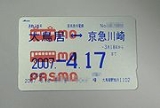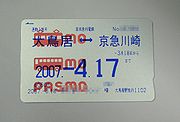
PASMO
Encyclopedia
is a rechargeable contactless smart card
ticketing system for public transport introduced in Tokyo
, Japan
, on March 18, 2007.
 Pasmo is a development of the system used by many non JR railway lines in the Tokyo region. The system offers interoperability with the JR Suica
Pasmo is a development of the system used by many non JR railway lines in the Tokyo region. The system offers interoperability with the JR Suica
system, as well as integrates private bus companies into the existing Passnet network.
The technology is based on RFID technology developed by Sony
corporation known as FeliCa
. Pasmo is available as a credit-card sized card.
Because of stronger than expected demand, general sales of Pasmo cards were halted in April 2007, less than one month after their introduction, in order to produce more cards. Approximately three million cards were sold before the restriction was enacted, of an allotment of just four million. Sales of regular Pasmo cards resumed on September 10, 2007. Until this date, only Pasmo commuter rail passes could be purchased. As of April 2009, over 11 million cards are in circulation.http://www.pasmo.co.jp/news/press/2009/04/13/release_090413.pdf
Transit systems/lines outside the Pasmo system but usable with the Pasmo card include:
Smart card
A smart card, chip card, or integrated circuit card , is any pocket-sized card with embedded integrated circuits. A smart card or microprocessor cards contain volatile memory and microprocessor components. The card is made of plastic, generally polyvinyl chloride, but sometimes acrylonitrile...
ticketing system for public transport introduced in Tokyo
Tokyo
, ; officially , is one of the 47 prefectures of Japan. Tokyo is the capital of Japan, the center of the Greater Tokyo Area, and the largest metropolitan area of Japan. It is the seat of the Japanese government and the Imperial Palace, and the home of the Japanese Imperial Family...
, Japan
Japan
Japan is an island nation in East Asia. Located in the Pacific Ocean, it lies to the east of the Sea of Japan, China, North Korea, South Korea and Russia, stretching from the Sea of Okhotsk in the north to the East China Sea and Taiwan in the south...
, on March 18, 2007.

Suica
is a rechargeable contactless smart card used as a fare card on train lines in Japan. Launched in November 2001, the card is usable currently in the Kantō region, at JR East stations near Sendai and Niigata...
system, as well as integrates private bus companies into the existing Passnet network.
The technology is based on RFID technology developed by Sony
Sony
, commonly referred to as Sony, is a Japanese multinational conglomerate corporation headquartered in Minato, Tokyo, Japan and the world's fifth largest media conglomerate measured by revenues....
corporation known as FeliCa
FeliCa
FeliCa is a contactless RFID smart card system from Sony in Japan, primarily used in electronic money cards. The name stands for Felicity Card...
. Pasmo is available as a credit-card sized card.
Because of stronger than expected demand, general sales of Pasmo cards were halted in April 2007, less than one month after their introduction, in order to produce more cards. Approximately three million cards were sold before the restriction was enacted, of an allotment of just four million. Sales of regular Pasmo cards resumed on September 10, 2007. Until this date, only Pasmo commuter rail passes could be purchased. As of April 2009, over 11 million cards are in circulation.http://www.pasmo.co.jp/news/press/2009/04/13/release_090413.pdf
Buses and tramways
Bus and tramway operators have been introducing Pasmo readers on their systems gradually.Popularity
On April 11, 2007, it was announced that sales of Pasmo fare cards would be limited to commuter rail pass purchases until August due to extremely high demand. It was originally predicted that approximately 2 million Pasmo cards would be sold in the first month, but about 3 million were actually sold, and stocks of Pasmo cards were running out.Usage with other systems
Through collaboration with JR East, passengers can use Pasmo cards wherever Suica cards are accepted to ride nearly any railway or bus in the Tokyo metropolitan area.Transit systems/lines outside the Pasmo system but usable with the Pasmo card include:
- SuicaSuicais a rechargeable contactless smart card used as a fare card on train lines in Japan. Launched in November 2001, the card is usable currently in the Kantō region, at JR East stations near Sendai and Niigata...
- East Japan Railway CompanyEast Japan Railway Companyis the largest passenger railway company in the world and one of the seven Japan Railways Group companies. The company name is officially abbreviated as JR East in English, and as in Japanese. The company's headquarters are in Yoyogi, Shibuya, Tokyo....
(JR East) lines in the Kanto, Niigata and Sendai areas - Tokyo MonorailTokyo Monorail, officially the , is a monorail system connecting Haneda Airport in Ōta, Tokyo, Japan, to Hamamatsuchō Station in Minato, Tokyo. The trains operate along an elevated line that follows the coast of Tokyo Bay. The trip from the airport to Hamamatsuchō costs ¥470 each way.-History:The line opened in...
- Saitama New Urban TransitIna LineThe New Shuttle , is a Japanese human-operated rubber-tyred automated guideway transit system.The 12.7-kilometre that runs north from Ōmiya Station in Saitama, Saitama, along Jōetsu Shinkansen through Ageo to Uchijuku Station in Ina in Saitama Prefecture in the Greater Tokyo Area is the only...
(New Shuttle) - Sendai Airport TransitSendai Airport LineThe is an airport rail link service connecting Sendai Airport to Sendai, Miyagi, Japan. Rail service began on March 18, 2007. The line was severely damaged by the 2011 Tōhoku earthquake and tsunami and service was suspended indefinitely from 11 March 2011, not reopening until 1 October, nearly 7...
- Tokyo Waterfront Area Rapid Transit (Rinkai Line)
- JR Bus Kantō (local buses in the Mito area)
- East Japan Railway Company
External links
- Official Pasmo website
- English part of the Pasmo website
- Media Release on integration between JR SuicaSuicais a rechargeable contactless smart card used as a fare card on train lines in Japan. Launched in November 2001, the card is usable currently in the Kantō region, at JR East stations near Sendai and Niigata...
and Pasmo system

